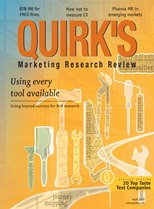Marketing research and insights news and information. This issue's keywords: opt-in e-mails; interactive ads; brand loyalty; junk mail; customer expectations
While, on average, consumers opt-in to receive e-mails from two retailers, between the two lists they have opted into they are receiving 13 e-mails a week shows a consumer survey from cloud-based technology company First Insight, Pittsburgh. The survey found that two-thirds of shoppers feel that receiving six or more e-mails a week from retailers is too many and 82 percent feel that constantly receiving irrelevant offers means that the retailers they are loyal to don't understand them. Additionally, the survey shows that consumers open one in four of the e-mails they receive and feel that 95 percent of the e-mails they receive are not at all relevant to them. Forty-four percent of consumers reported that they have unsubscribed from a retail e-mail list in the past six months and 40 percent said that they would go out of their way to shop at a store that doesn't waste their time with irrelevant e-mail offers. Sixty-one percent of consumers say that their favorite retailers only send them one or two e-mails a week and 43 percent say they would be more likely to open e-mails from retailers if they knew those e-mails contained personalized suggestions of products or clothing that aligned with past purchases rather than promoting products that were generally available or on sale.
In Los Angeles, audience technology company YuMe Inc. and researcher Ipsos have released a new study showing that interactive ad features significantly increase attention, recall and message breakthrough. The study was predicated in part on the concept of implicit reaction time, which measures how quickly and closely a respondent's brain connects networks of associations that are the foundations for images, feelings and intentions. A faster user response indicates a stronger and more emphatic connection with a brand or product and, therefore, a higher conviction to purchase it. Interactive ads, according to this theory, succeed in these case studies because they increase certainty, illustrated by a shorter reaction time, and thus facilitate higher conviction and less inhibition. The study presented people with 11 different ad formats, representing five brands, on PCs, mobile phones and connected TV sets, finding positive impact of interactivity on ad engagement. The findings show that a positive media experience increases the chances for higher ad transference, resulting in stronger brand impact. The more interactive the ad units, the greater the impact on conviction across all brand associations. As a result, the level of interaction can potentially create stronger brand associations and connections.
The cost and complexity of smart home systems and devices is threatening consumer adoption and brand loyalty according to a survey by software and services firm Support.com Inc., Redwood City, Calif. The survey, which examined the drivers and barriers of smart home usage and behavior for both smart home owners and potential buyers, shows that 67 percent of potential buyers say the cost to buy, set up and maintain a smart home system is the No. 1 barrier to purchasing smart home devices or systems. Additionally, 31 percent of smart home owners surveyed struggle with the complexity of configuration and technical support of smart home devices and systems, while 43 percent of potential buyers are concerned about the complexity of installation and the connectivity of smart home devices. Nearly half (49 percent) of potential buyers are concerned that they won't be able to fix smart home device and system issues on their own, while 61 percent of smart home owners want to fix issues on their own and are frustrated if they can't.
Eighty-four percent of U.K. consumers say they are ready to take action against brands for the amount of irrelevant communication they receive shows a study carried out by Coleman Parkes for IT services firm Ricoh. Additionally, 46 percent see junk mail as more frustrating than their commute to work and 69 percent say they feel less loyal to a brand spamming them with irrelevant information. U.K. consumers perceive around a quarter of what they currently receive to be junk mail. The study also shows that 64 percent of U.K. consumers believe more can be done to tailor communications and 76 percent would be willing to share personal data to make communications more relevant, including occupation, salary, online browsing habits and health records. More than two-thirds say they will punish a brand by spending less and 57 percent say they will stop being a customer. Twenty-two percent have complained to a service provider and 14 percent have taken their complaint to a relevant authority.
When mobile expectations are not met, 93 percent of those surveyed take immediate action, with 33 percent never purchasing from the brand again according to a global consumer study by experience management software firm Sitecore, Sausalito, Calif. conducted in conjunction with Vanson Bourne. Alternatively, when a good mobile experience is achieved, 76 percent report that it has an influence on their loyalty to a brand. The study also found that 62 percent of consumers say they are willing to share online activity and preferences to varying degrees in order to receive a more personalized customer experience when making an online purchase. Additionally, two-thirds of those surveyed say their expectations and requirements as a customer will change within the next three years. Ordering on the move (27 percent) and having mobile apps that can adapt and react to location (25 percent) are expected to become requirements for consumers over the next three years.
These reports were compiled from recent issues of the Daily News Queue, a free e-newsletter digest of marketing research and insights news and information delivered each business morning. Not already in the Queue? Sign up here!
